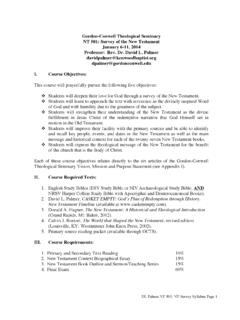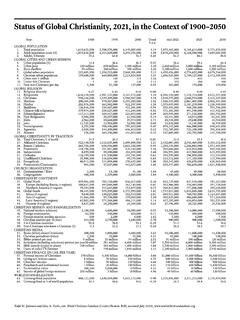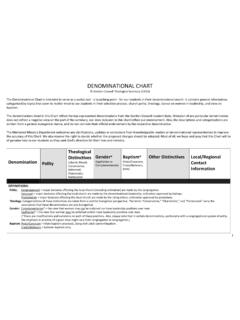Transcription of Schein, E. Organizational Culture and Leadership
1 Organizational Culture and Leadership by Edgar H. Schein Jossey-Bass, 3rd edition, 2004 Reviewed by David W. Gill I am a strong believer in the importance of corporate Culture . I believe that Culture is more important than codes and training programs in determining ethical performance. Accidental cultures .. misaligned cultures .. toxic cultures .. these are the enemies of good business and good ethics. There has been a significant rise in interest in corporate Culture in recent years, partly (I believe) because of the failure of the codes, dilemmas, and decision-making focus of so much business ethics education --- and partly because of the positive emphasis on Culture by business leaders and writers such as Lou Gerstner, Jim Collins, and Max DePree. I have mixed feelings about a lot of the literature on corporate Culture , however, because it doesn t seem deep or holistic enough.
2 It often focuses on one aspect of Culture such as the office atmosphere or rituals or invisible thinking behind company behavior. My own understanding of Culture comes much more from reading in cultural anthropology and sociology ( , Malinowski, Durkheim, Weber). I think we should study corporate Culture much as Indiana Jones and his ilk would study a new people group. The one book that stands apart from all others on this topic is Edgar H. Schein s classic Organizational Culture and Leadership now in its third edition. Schein gives us 400 pages of brilliant insight, drawing not just from the great sociologists and anthropologists but from social psychologists and Organizational behavior experts. He is now retired after a long and distinguished career as professor at MIT s Sloan School of Management. Schein also worked extensively as a consultant with many companies and organizations over the years.
3 His book is well-written, thoroughly tested in the business trenches as well as the ivory towers. Schein organizes his study in three sections. First he defines Organizational Culture (and Leadership ). In part two he goes into great detail unpacking the dimensions of Culture . Finally, in part three, Schein turns to the Leadership role in Culture building and changing. Culture is to organizations what character is to individuals, Schein says. Culture is about phenomena beneath the surface that constrain and guide behavior. Leadership creates and changes Culture but Culture also affects and even defines Leadership in organizations. It is a critical reciprocal relationship. Schein provides a great list of various categories used to describe Culture ; immediately it is clear that he has a grasp of the field matched by few others. Schein defines Culture as a pattern of shared basic assumptions that was learned by a group as it solved its problems of external adaption and internal integration (p.)
4 17). He argues that there are three basic levels of corporate Culture : (1) artifacts by which he means not only physical infrastructure but Organizational processes and policies, myths, rituals, and the climate ; (2) espoused beliefs and values --- the core values list, etc.; (3) basic assumptions --- taken for granted beliefs, perceptions, thoughts, It is this last level that is decisive for Schein. Schein does a great job of showing how charismatic founding leaders create shared Culture as the young organization succeeds in managing its external and internal challenges by acting on one or another value or perspective. Success breeds deeper commitment and cultural habit. Schein shows how mission and vision get concretized in specific goals and strategies and drive cultural development by requiring and reinforcing certain habits of thought and action until those become taken-for-granted assumptions.
5 Schein s discussion (Chapter 13) of How Leaders Embed and Transmit Culture is a superb account of how cultural values (assumptions) must be embedded, articulated, and reinforced in reward and compensation systems, role modeling, HR practices, budgeting, Organizational design, physical space, rites and rituals, and formal statements of values and philosophy. His discussions of how Leadership can affect Culture in young, mid-life, or mature organizations, and of the kinds of events and needs that can provoke cultural change, are uniformly insightful. He gives lots of illustrations from different companies he has worked with. My own view of Culture is very close to that of Schein although I organize it a little differently. I think of Culture as having four levels: (1) physical infrastructure, (2) Organizational infrastructure, (3) personnel, and (4) rituals and informal climate and style.
6 Each of these aspects of the Culture are already embedded with values though often unexamined and in conflict. I view the role of Leadership as answering in a very proactive way these questions: what is our mission and vision in this company (and can we create a succinct, helpful statement of that actual purpose)? What are the critical core values (habits, characteristics, traits, capabilities and inclinations, assumptions) that we need to have embedded at all four levels of our Culture to enable the achievement of our mission and vision with excellence? These values need to be identified, then communicated, then implemented concretely, then evaluated and measured. That s what leaders do --- with the collegial expertise and ownership of their people. This review hardly does justice to the depth of Schein s exploration. This is one of those books that I really believe will help any manager or leader to rise to a higher level of understanding and expertise.
7











